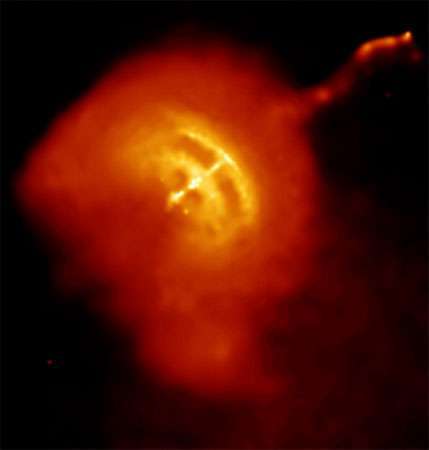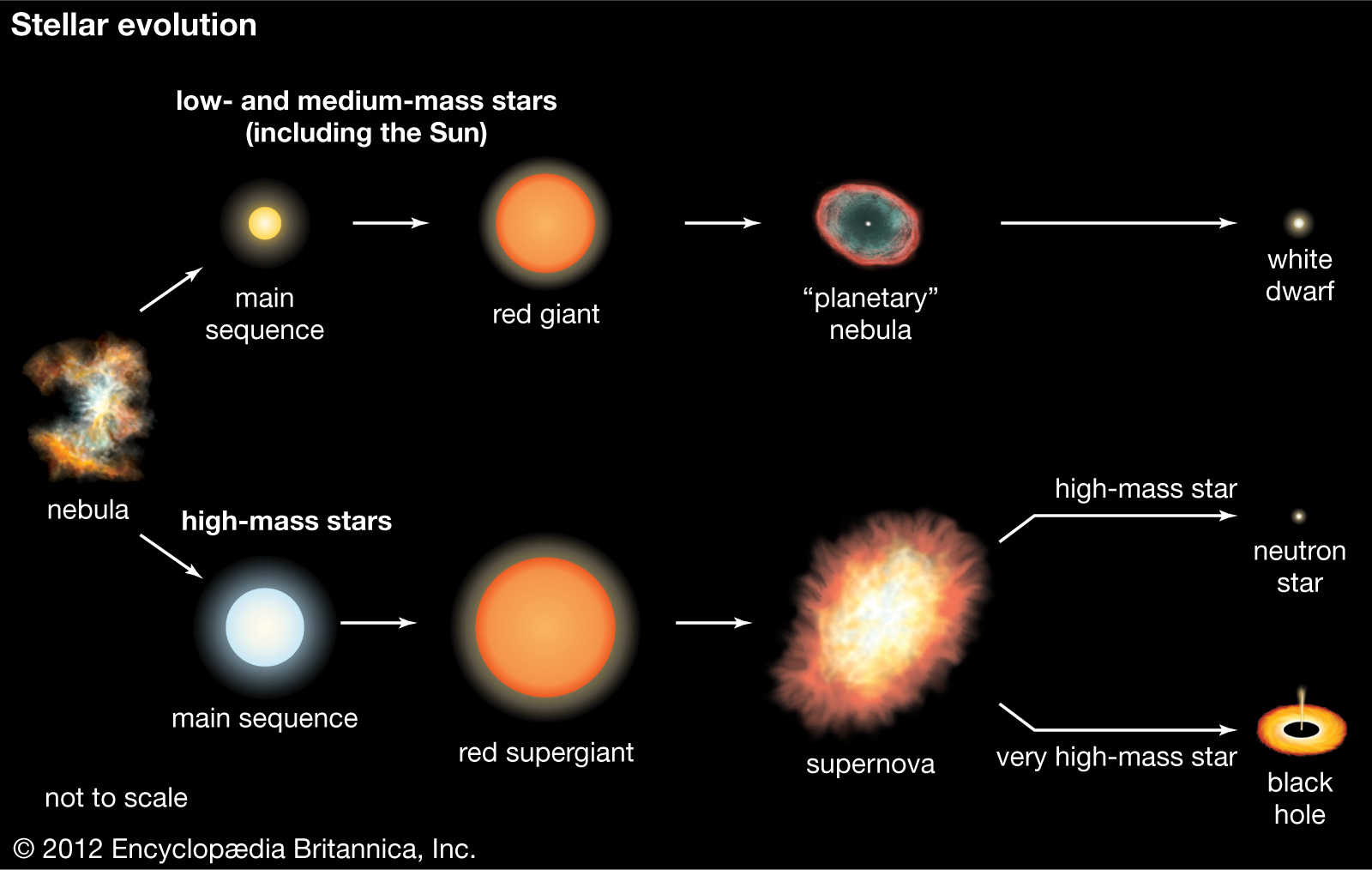



Fritz Zwicky together with colleague Walter Baade, Zwicky pioneered and promoted the use of the first Schmidt telescopes used in a mountain-top observatory in 1935. In 1934 he and Baade coined the term "supernova" and hypothesized that supernovae were the transition of normal stars into neutron stars, as well as the origin of cosmic rays. This was an opinion which contributed to determining the size and age of the universe subsequently.
In support of this hypothesis, Zwicky started looking for supernovae, and found a total of 120 by himself (and one more, SN 1963J, in concert with Paul Wild) over 52 years (SN 1921B through SN 1973K), a record which stood until 2009 when passed by Tom Boles. Zwicky did his laborious work comparing photographic plates with the human eye which is far more challenging and difficult than Boles accomplished using modern technology for his record.
Neutron star, any of a class of extremely dense, compact stars thought to be composed primarily of neutrons. Neutron stars are typically about 20 km (12 miles) in diameter. Their masses range between 1.18 and 1.97 times that of the Sun, but most are 1.35 times that of the Sun. Thus, their mean densities are extremely high—about 1014 times that of water. This approximates the density inside the atomic nucleus, and in some ways a neutron star can be conceived of as a gigantic nucleus. It is not known definitively what is at the centre of the star, where the pressure is greatest; theories include hyperons, kaons, and pions. The intermediate layers are mostly neutrons and are probably in a “superfluid” state. The outer 1 km (0.6 mile) is solid, in spite of the high temperatures, which can be as high as 1,000,000 K. The surface of this solid layer, where the pressure is lowest, is composed of an extremely dense form of iron.
Another important characteristic of neutron stars is the presence of very strong magnetic fields, upward of 1012 gauss (Earth’s magnetic field is 0.5 gauss), which causes the surface iron to be polymerized in the form of long chains of iron atoms. The individual atoms become compressed and elongated in the direction of the magnetic field and can bind together end-to-end. Below the surface, the pressure becomes much too high for individual atoms to exist.
The discovery of pulsars in 1967 provided the first evidence of the existence of neutron stars. Pulsars are neutron stars that emit pulses of radiation once per rotation. The radiation emitted is usually radiowaves, but pulsars are also known to emit in optical, X-ray, and gamma-ray wavelengths. The very short periods of, for example, the Crab (NP 0532) and Vela pulsars (33 and 83 milliseconds, respectively) rule out the possibility that they might be white dwarfs. The pulses result from electrodynamic phenomena generated by their rotation and their strong magnetic fields, as in a dynamo. In the case of radio pulsars, neutrons at the surface of the star decay into protons and electrons. As these charged particles are released from the surface, they enter the intense magnetic field that surrounds the star and rotates along with it. Accelerated to speeds approaching that of light, the particles give off electromagnetic radiation by synchrotron emission. This radiation is released as intense radio beams from the pulsar’s magnetic poles.

The Vela Pulsar, as seen by the Chandra X-ray Observatory.
Many binary X-ray sources, such as Hercules X-1, contain neutron stars. Cosmic objects of this kind emit X-rays by compression of material from companion stars accreted onto their surfaces.
Neutron stars are also seen as objects called rotating radio transients (RRATs) and as magnetars. The RRATs are sources that emit single radio bursts but at irregular intervals ranging from four minutes to three hours. The cause of the RRAT phenomenon is unknown. Magnetars are highly magnetized neutron stars that have a magnetic field of between 1014 and 1015 gauss.
As the star's core collapses, its rotation rate increases as a result of conservation of angular momentum, hence newly formed neutron stars rotate at up to several hundred times per second. Some neutron stars emit beams of electromagnetic radiation that make them detectable as pulsars. Indeed, the discovery of pulsars by Jocelyn Bell Burnell in 1967 was the first observational suggestion that neutron stars exist. The radiation from pulsars is thought to be primarily emitted from regions near their magnetic poles. If the magnetic poles do not coincide with the rotational axis of the neutron star, the emission beam will sweep the sky, and when seen from a distance, if the observer is somewhere in the path of the beam, it will appear as pulses of radiation coming from a fixed point in space (the so-called "lighthouse effect"). The fastest-spinning neutron star known is PSR J1748-2446ad, rotating at a rate of 716 times a second or 43,000 revolutions per minute, giving a linear speed at the surface on the order of 0.24 c (i.e. nearly a quarter the speed of light).

Radiation from the pulsar PSR B1509-58, a rapidly spinning neutron star, makes nearby gas glow in X-...
There are thought to be around 100 million neutron stars in the Milky Way, a figure obtained by estimating the number of stars that have undergone supernova explosions. However, most are old and cold, and neutron stars can only be easily detected in certain instances, such as if they are a pulsar or part of a binary system. Slow-rotating and non-accreting neutron stars are almost undetectable; however, since the Hubble Space Telescope detection of RX J185635-3754, a few nearby neutron stars that appear to emit only thermal radiation have been detected. Soft gamma repeaters are conjectured to be a type of neutron star with very strong magnetic fields, known as magnetars, or alternatively, neutron stars with fossil disks around them.
Neutron stars in binary systems can undergo accretion which typically makes the system bright in X-rays while the material falling onto the neutron star can form hotspots that rotate in and out of view in identified X-ray pulsar systems. Additionally, such accretion can "recycle" old pulsars and potentially cause them to gain mass and spin-up to very fast rotation rates, forming the so-called millisecond pulsars. These binary systems will continue to evolve, and eventually the companions can become compact objects such as white dwarfs or neutron stars themselves, though other possibilities include a complete destruction of the companion through ablation or merger. The merger of binary neutron stars may be the source of short-duration gamma-ray bursts and are likely strong sources of gravitational waves. In 2017, a direct detection (GW170817) of the gravitational waves from such an event was made, and gravitational waves have also been indirectly detected in a system where two neutron stars orbit each other.
Most investigators believe that neutron stars are formed by supernova explosions in which the collapse of the central core of the supernova is halted by rising neutron pressure as the core density increases to about 1015 grams per cubic cm. If the collapsing core is more massive than about three solar masses, however, a neutron star cannot be formed, and the core would presumably become a black hole.

Stellar evolution.
Any main-sequence star with an initial mass of above 8 times the mass of the sun (8 M☉) has the potential to produce a neutron star. As the star evolves away from the main sequence, subsequent nuclear burning produces an iron-rich core. When all nuclear fuel in the core has been exhausted, the core must be supported by degeneracy pressure alone. Further deposits of mass from shell burning cause the core to exceed the Chandrasekhar limit. Electron-degeneracy pressure is overcome and the core collapses further, sending temperatures soaring to over 5×109 K. At these temperatures, photodisintegration (the breaking up of iron nuclei into alpha particles by high-energy gamma rays) occurs. As the temperature climbs even higher, electrons and protons combine to form neutrons via electron capture, releasing a flood of neutrinos. When densities reach nuclear density of 4×1017 kg/m3, neutron degeneracy pressure halts the contraction. The infalling outer envelope of the star is halted and flung outwards by a flux of neutrinos produced in the creation of the neutrons, becoming a supernova. The remnant left is a neutron star. If the remnant has a mass greater than about 3 M☉, it collapses further to become a black hole.
As the core of a massive star is compressed during a Type II supernova, Type Ib or Type Ic supernova, and collapses into a neutron star, it retains most of its angular momentum. But, because it has only a tiny fraction of its parent's radius (and therefore its moment of inertia is sharply reduced), a neutron star is formed with very high rotation speed, and then over a very long period it slows. Neutron stars are known that have rotation periods from about 1.4 ms to 30 s. The neutron star's density also gives it very high surface gravity, with typical values ranging from 1012 to 1013 m/s2 (more than 1011 times that of Earth). One measure of such immense gravity is the fact that neutron stars have an escape velocity ranging from 100,000 km/s to 150,000 km/s, that is, from a third to half the speed of light. The neutron star's gravity accelerates infalling matter to tremendous speed. The force of its impact would likely destroy the object's component atoms, rendering all the matter identical, in most respects, to the rest of the neutron star.

Simplistic representation of the formation of neutron stars.
REFERENCES
Encyclopaedia Britannica. Available in: https://www.britannica.com/science/neutron-star. Access in: 26/11/2018.
Nasa. Available in: https://www.nasa.gov/centers/goddard/news/gsfc/spacesci/pictures/2003/0702pulsarspeed/0702ssu_primer.html. Access in: 26/11/2018.
Wikipedia. Available in: https://en.wikipedia.org/wiki/Fritz_Zwicky. Access in: 26/11/2018.
Wikipedia. Available in: https://en.wikipedia.org/wiki/Neutron_star. Access in: 26/11/2018.

Default timespace